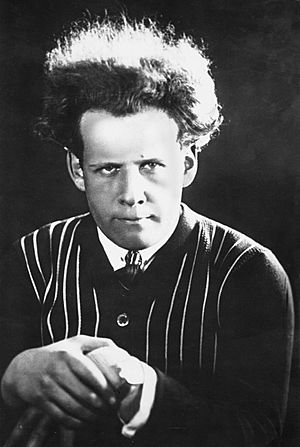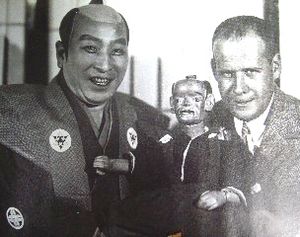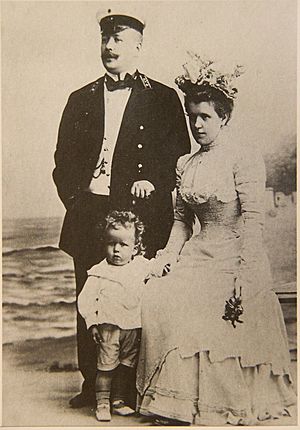Sergei Eisenstein facts for kids
Quick facts for kids
Sergei Eisenstein
|
|
|---|---|

Eisenstein in St. Petersburg, 1910s
|
|
| Born |
Sergei Mikhailovich Eizenshtein
22 January 1898 (O.S. 10 January 1898) Riga, Governorate of Livonia, Russian Empire
|
| Died | 11 February 1948 (aged 50) |
| Resting place | Novodevichy Cemetery, Moscow |
| Years active | 1923–1946 |
|
Notable work
|
|
| Spouse(s) | Pera Atasheva (birth name Pearl Fogelman) 1934–1948, his death |
| Awards | Stalin prize (1941,1946) |
Sergei Mikhailovich Eisenstein (born January 22, 1898 – died February 11, 1948) was a famous Soviet film director. He was known for creating new ways to make movies, especially using a technique called montage. Montage is when you put many short shots together to create a new meaning or feeling.
Eisenstein directed several important films. These include silent movies like Strike (1925), Battleship Potemkin (1925), and October (1928). He also made historical epic films such as Alexander Nevsky (1938) and Ivan the Terrible (1944, 1958). His film Battleship Potemkin is often called one of the greatest movies ever made.
Contents
Early Life and Family
Sergei Eisenstein was born in Riga on January 22, 1898. At that time, Riga was part of the Russian Empire. His family was middle-class, and they moved often when he was young. Sergei also moved around a lot throughout his life.
His father, Mikhail Osipovich Eisenstein, was an architect. Mikhail was born in the Kiev Governorate. His mother, Julia Ivanovna Konetskaya, came from a wealthy Russian Orthodox family.
In 1905, his mother Julia left Riga and took Sergei to St. Petersburg. His father joined them around 1910. Later, his parents divorced, and Julia moved to France. Sergei was raised as an Orthodox Christian, but he became an atheist when he was older.
Education and Early Career
Eisenstein studied architecture and engineering. He attended the Petrograd Institute of Civil Engineering, following his father's profession.
In 1918, he left school to join the Red Army. He fought in the Russian Civil War. His father, however, supported the other side. After the war, his father moved to Germany. Sergei went to different cities like Petrograd and Minsk.
In 1920, Sergei was put in charge of a unit in Minsk. He was very good at creating propaganda for the October Revolution. During this time, he learned about Kabuki theatre from Japan. He also studied Japanese and learned many characters. He said this helped him develop his visual style in filmmaking.
Becoming a Film Director

Eisenstein moved to Moscow in 1920 and started working in theatre. He directed plays like Gas Masks and Listen Moscow. His very first film, Glumov's Diary, was made in the same year. It was part of a theatre production.
His first full-length movie was Strike (1925). After that, he directed Battleship Potemkin (also 1925). This film became famous all over the world. Because of its success, he was able to direct October: Ten Days That Shook the World. This film celebrated the tenth anniversary of the 1917 October Revolution.
He then made The General Line, also known as Old and New. Critics outside the Soviet Union praised these films. However, some Soviet film experts criticized Eisenstein. They thought he focused too much on camera angles and montage.
Eisenstein's film Alexander Nevsky was very popular. Both in the Soviet Union and in other countries, people liked it. This film earned him important awards, including the Order of Lenin and the Stalin Prize.
His film Ivan the Terrible, Part I, showed Ivan IV of Russia as a national hero. This film was approved by Stalin and won another Stalin Prize. However, the next part, Ivan the Terrible, Part II, was criticized. It was not released until 1958. A third part of Ivan the Terrible was never finished. Most of its filmed scenes were destroyed by Soviet authorities.
Later Life and Death
Sergei Eisenstein had a heart attack in February 1946. He spent much of the next year getting better. He died from a second heart attack on February 11, 1948. He was 50 years old.
His body was displayed for people to pay their respects. He was cremated on February 13. His ashes were buried in the Novodevichy Cemetery in Moscow.
Filmography
- 1923 Glumov's Diary (short film)
- 1925 Strike
- 1925 Battleship Potemkin
- 1928 October: Ten Days That Shook the World
- 1929 The Storming of La Sarraz (lost film)
- 1929 The General Line (also known as Old and New)
- 1930 Romance sentimentale (France)
- 1931 El Desastre en Oaxaca (Mexico)
- 1938 Alexander Nevsky
- 1944 Ivan the Terrible, Part I
- 1958 Ivan the Terrible, Part II (completed in 1946)
Images for kids
See also
 In Spanish: Serguéi Eisenstein para niños
In Spanish: Serguéi Eisenstein para niños



